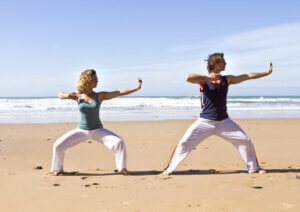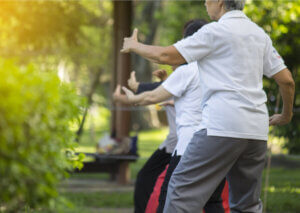How to Practice Chi Kung

Also known as Qigong, Chi Kung is a set of techniques linked to traditional Chinese medicine. In Chi Kung, you practice a number of physical, mental, and breathing exercises to improve your overall health.
However, for Taoists and Buddhists, Chi Kung is also a way of achieving enlightenment. The literal translation of Chi Kung is “vital energy cultivation”, and ‘life energy’ is a key part of Asian cultures.
What is Chi Kung?
Chi Kung can be put in the same group as Reiki and Taichi. All of them are traditional eastern therapies that aim to channel life energy properly around the body.
There are many different ways to practice Chi Kung or Qigong, whether through movement or staying perfectly still. The oldest exercises date back to the Zhou dynasty, in the 6th century BC.
There are over 20 different popular systems, but the most popular is called Wuqinxi, which means “frolics of the five animals”. Its creator was a doctor named Hua Tuo and it involves imitating the movements of a tiger, deer, monkey, bear, and a crane. Each one of these animals has its own characteristics, attitudes, and spirit.
Chi Kung seeks the unification of body and mind. It can help to calm ourselves down and focus on our thoughts and breathing. It also requires a careful focus on movement, similar to yoga.
What are the benefits of Chi Kung?

Despite being thousands of years old, this therapeutic practice can be beneficial on many different levels. These can be mental, physical, emotional, or spiritual, as claimed in a study published in the American Journal of Health Promotion.
On the mental level, this practice guides internal energy to reduce negative thoughts and worries. It’s also supposed to help you to sleep better, think more clearly, and even improve your memory. Although, the study mentioned above only looks at the benefits of sleeping.
At the physical level, Chi Kung stimulates the body’s vital organs. This can have a number of benefits including better intestinal transit, and increased flexibility. It can also prevent problems caused by a sedentary lifestyle, provide good exercise for your muscles, and improve blood circulation. Unlike the mental benefits of Chi Kung, all these benefits have been observed scientifically.
Regarding the emotional benefits, this activity helps to regulate circulation around the channels and the internal organs linked to our feelings. According to the Five Elements Theory, the heart contains euphoria, the spleen contains worry, the liver contains anger, the kidney contains fear, and the lungs contain sadness.
And finally, on the spiritual level, the tradition claims to be necessary to be at one with nature, develop human qualities, keep healthy habits, and improve one’s lifestyle.
How to practice Chi Kung
Chi Kung basically involves three vital processes: mind, body, and breathing. This in turn requires three basic steps, the first of which is to relax your body.
The next step is to control your breathing so that it’s calm and constant. There’s a guide that contains eight ways of breathing, and the keywords are: calm, gentle, deep, long, continuous, uniform, slow, and delicate.
Finally, you need to control your mind, which will also be an important part of relaxing your body and controlling your breathing. Below, we’ve included some basic Chi Kung exercises as an introduction:
1. Tonification exercise
Standing, lift your arms whilst breathing through your nose. Separate your arms and let them slowly drop whilst you breathe out slowly through your mouth. Finally, bend your knees and keep your back straight throughout the exercise.
2. Sedation exercise
First, breathe in through the nose and move your arms away from your body. Then, breathe out through your mouth whilst bringing your arms towards your chest.

3. Stretching exercise
First, breathe in through the nose and stretch your arms upwards, pointing towards the sky. Then, lean back a little to stretch the knees and your trunk. Lastly, breathe out through the mouth and bring your body forward, relaxing your legs, arms, and back. Maintain each posture for between 20 and 45 seconds.
What’s the difference between Chi Kung and Tai Chi?
Many people ask what the difference is between Chi Kung and Tai Chi. Whilst both disciplines focus on posture and breathing with slow, coordinated movements, there are some key differences.
Chi Kung is the “mother” of Tai Chi, given that it’s more than 3,600 years old. Tai Chi is considered instead to be a more advanced form. Another key difference is that Qigong aims to prevent illness, whilst Tai Chi aims to improve your overall health.
Furthermore, you can learn Chi Kung in a relatively short period of time, whilst Tai Chi requires practicing five traditional techniques: Chen, Wu, Yang, Sun, and Wu.
Lastly, you can practice Qigong either standing or sitting down and you only do an exercise once in each session. Tai Chi on the other hand is always done standing and follows a memorized sequence of movements.
Also known as Qigong, Chi Kung is a set of techniques linked to traditional Chinese medicine. In Chi Kung, you practice a number of physical, mental, and breathing exercises to improve your overall health.
However, for Taoists and Buddhists, Chi Kung is also a way of achieving enlightenment. The literal translation of Chi Kung is “vital energy cultivation”, and ‘life energy’ is a key part of Asian cultures.
What is Chi Kung?
Chi Kung can be put in the same group as Reiki and Taichi. All of them are traditional eastern therapies that aim to channel life energy properly around the body.
There are many different ways to practice Chi Kung or Qigong, whether through movement or staying perfectly still. The oldest exercises date back to the Zhou dynasty, in the 6th century BC.
There are over 20 different popular systems, but the most popular is called Wuqinxi, which means “frolics of the five animals”. Its creator was a doctor named Hua Tuo and it involves imitating the movements of a tiger, deer, monkey, bear, and a crane. Each one of these animals has its own characteristics, attitudes, and spirit.
Chi Kung seeks the unification of body and mind. It can help to calm ourselves down and focus on our thoughts and breathing. It also requires a careful focus on movement, similar to yoga.
What are the benefits of Chi Kung?

Despite being thousands of years old, this therapeutic practice can be beneficial on many different levels. These can be mental, physical, emotional, or spiritual, as claimed in a study published in the American Journal of Health Promotion.
On the mental level, this practice guides internal energy to reduce negative thoughts and worries. It’s also supposed to help you to sleep better, think more clearly, and even improve your memory. Although, the study mentioned above only looks at the benefits of sleeping.
At the physical level, Chi Kung stimulates the body’s vital organs. This can have a number of benefits including better intestinal transit, and increased flexibility. It can also prevent problems caused by a sedentary lifestyle, provide good exercise for your muscles, and improve blood circulation. Unlike the mental benefits of Chi Kung, all these benefits have been observed scientifically.
Regarding the emotional benefits, this activity helps to regulate circulation around the channels and the internal organs linked to our feelings. According to the Five Elements Theory, the heart contains euphoria, the spleen contains worry, the liver contains anger, the kidney contains fear, and the lungs contain sadness.
And finally, on the spiritual level, the tradition claims to be necessary to be at one with nature, develop human qualities, keep healthy habits, and improve one’s lifestyle.
How to practice Chi Kung
Chi Kung basically involves three vital processes: mind, body, and breathing. This in turn requires three basic steps, the first of which is to relax your body.
The next step is to control your breathing so that it’s calm and constant. There’s a guide that contains eight ways of breathing, and the keywords are: calm, gentle, deep, long, continuous, uniform, slow, and delicate.
Finally, you need to control your mind, which will also be an important part of relaxing your body and controlling your breathing. Below, we’ve included some basic Chi Kung exercises as an introduction:
1. Tonification exercise
Standing, lift your arms whilst breathing through your nose. Separate your arms and let them slowly drop whilst you breathe out slowly through your mouth. Finally, bend your knees and keep your back straight throughout the exercise.
2. Sedation exercise
First, breathe in through the nose and move your arms away from your body. Then, breathe out through your mouth whilst bringing your arms towards your chest.

3. Stretching exercise
First, breathe in through the nose and stretch your arms upwards, pointing towards the sky. Then, lean back a little to stretch the knees and your trunk. Lastly, breathe out through the mouth and bring your body forward, relaxing your legs, arms, and back. Maintain each posture for between 20 and 45 seconds.
What’s the difference between Chi Kung and Tai Chi?
Many people ask what the difference is between Chi Kung and Tai Chi. Whilst both disciplines focus on posture and breathing with slow, coordinated movements, there are some key differences.
Chi Kung is the “mother” of Tai Chi, given that it’s more than 3,600 years old. Tai Chi is considered instead to be a more advanced form. Another key difference is that Qigong aims to prevent illness, whilst Tai Chi aims to improve your overall health.
Furthermore, you can learn Chi Kung in a relatively short period of time, whilst Tai Chi requires practicing five traditional techniques: Chen, Wu, Yang, Sun, and Wu.
Lastly, you can practice Qigong either standing or sitting down and you only do an exercise once in each session. Tai Chi on the other hand is always done standing and follows a memorized sequence of movements.
All cited sources were thoroughly reviewed by our team to ensure their quality, reliability, currency, and validity. The bibliography of this article was considered reliable and of academic or scientific accuracy.
- Barrow DE, Bedford A, Ives G, et al. 2007. An evaluation of the effects of Tai Chi Chuan and Chi Kung training in patients with symptomatic heart failure: a randomised controlled pilot study. Postgraduate Medical Journal. https://pmj.bmj.com/content/83/985/717
- Jahnke, R., Larkey, L., Rogers, C., Etnier, J., & Lin, F. (2010). A comprehensive review of health benefits of qigong and tai chi. American Journal of Health Promotion : AJHP, 24(6), e1–e25. https://doi.org/10.4278/ajhp.081013-LIT-248
This text is provided for informational purposes only and does not replace consultation with a professional. If in doubt, consult your specialist.








